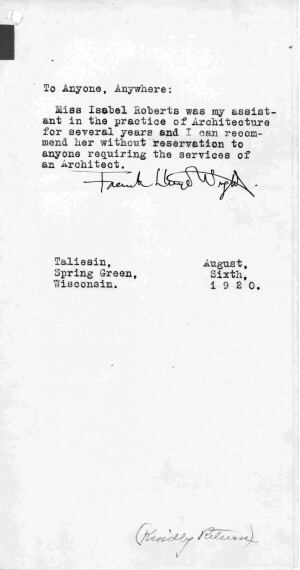
Photographs from Frank Lloyd Wright’s Wisconsin- and Arizona-based Taliesin studios show women working next to men in the drafting room and out in the field, carrying stone and pouring concrete. In an era when few women studied architecture and even fewer practiced, who were these pioneers?
That’s what officials at the Guggenheim Museum asked Beverly Willis in 2007. They hoped Willis—a now-retired architect who runs an eponymous foundation dedicated to collecting and promoting the stories of women architects—could organize a program as part of this year’s festivities surrounding the 50th anniversary of the museum’s landmark Wright building in New York City.
Willis was stymied. “Typically, we find scholars on a topic we want to discuss. But there is no scholarship on women professionals” in Wright’s office, she says. That didn’t deter the 81-year-old women’s advocate. “The fact that there’s nothing out there doesn’t mean to me that there’s nothing out there. A woman’s designs are similar to chalk on a blackboard. You can write all of your accomplishments, but there’s an eraser following behind. I knew that there was a lot of information that had been lost.”
Willis started reading the fine print in the hundreds of books on Wright’s history, tracking references to women in footnotes and endnotes. “I realized that if I picked up these little bits or phrases, I’d put together a narrative,” she says. Over the next year and a half, Willis collected enough material to piece together a 15-minute documentary, “A Girl Is a Fellow Here”: 100 Women Architects in the Studio of Frank Lloyd Wright. (The quote in the title comes from the master himself.) The film premiered in June at the Guggenheim as part of a panel discussion that included Willis; New Republic architecture critic Sarah Williams Goldhagen; psychologist and New York University professor Carol Gilligan; and Columbia University architecture professor Gwendolyn Wright. An honored guest was Lois Davidson Gottlieb, one of the scores of women who worked with Wright.

Willis’ documentary reveals that the architect’s first employee and lead designer was a woman, Marion Mahoney. Another early employee, Isabel Roberts, is referred to as Wright’s bookkeeper in some history books. Willis found a letter from Wright recommending Roberts’ services as an architect. “This is big,” Willis notes. “It’s completely rewriting the historical statement.” The letter was found in the course of another Beverly Willis Architecture Foundation project: a hand count of the women in AIA records from the organization’s beginning until 1980. Roberts had applied to become an AIA member; she was denied, but the institute kept her application materials.
Roberts, Mahoney, and four other women who worked in Wright’s studio—Gottlieb, Jane Duncombe, Eleanore Pettersen, and Read Weber—are the primary focus of Willis’ documentary. She chose her subjects because of the quality of their work, and because she could find examples of their work. “I’m not a researcher,” Willis insists. In fact, she hopes to give all of the information and images she has compiled to someone who will dig deeper into the story of the women in Wright’s studios.
“I have worked through almost half of the 20th century,” says Willis, who opened her first architecture office in 1958 and established her foundation in 2002. “I have seen lauded women’s work vanish as if it never existed. This must stop.” Thanks to “A Girl Is a Fellow Here”, the women employed by Wright—and their work—have become a little more visible.
“A Girl Is a Fellow Here” will be distributed to architecture schools and can be purchased at museum stores, historic Wright sites, and the Beverly Willis Architecture Foundation website (bwaf.org).















